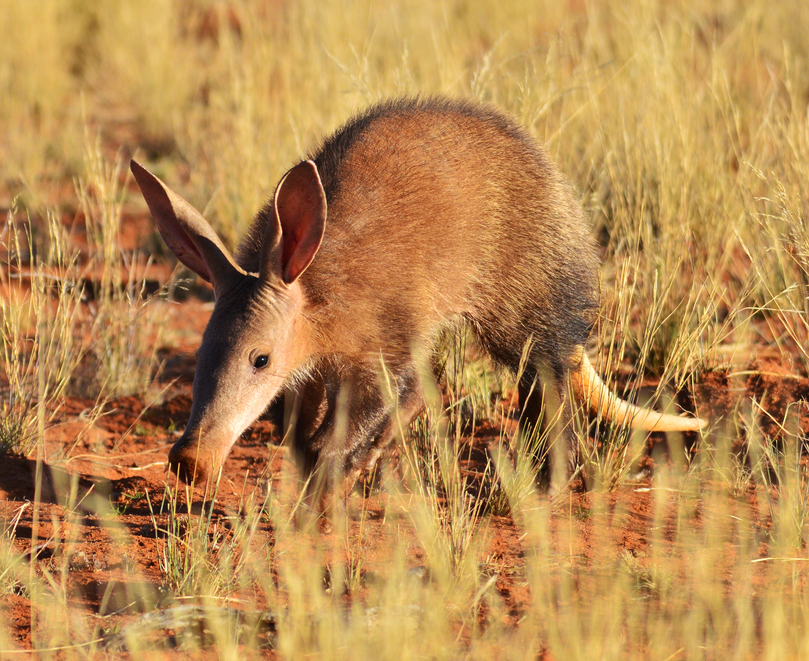Aardvarks (Aard-Vark, Dutch for “earth-pig”), are one-of-a-kind animals, one of the strangest mammals you will ever encounter. They have a body like a large rat, a long snout like an ant eater, a pig nose, long ears like a rabbit, pink skin with coarse hair like a pig (but in contrast to pigs, aardvarks have very thick skin and lack a fat layer), short legs, feet like a pig and a long thin tail that resembles a kangaroo’s tail (Hutchins, 2004, p. 155). Their barrel-shaped body weighs between 100 and 180 pounds (50 to 83 kg). The greatly elongated head-snout is set on a short thick neck. The tail is thick at the base and gradually tapers. So strange was it that, when described to European naturalists, many doubted its reality (Catchpoole, 2014, p. 28).
The entire body is expertly designed to consume ants and termites. The 18-inch-long tongue secretes sticky saliva like ant eaters to help them ingest up to as many as 50,000 insects in one night (Burton, 1991, p. 2). Its highly developed salivary glands almost completely surround the neck to produce the sticky saliva to catch ants. It can also shove its nose into an ants’ nest and suck up a meal like a vacuum cleaner. The narrow, flat tongue can roll up like a straw to suck in small passages.
The teeth, instead of having a pulp cavity as is true of all other mammals, are one-of-a-kind, consisting of a cluster of 1,500 thin, hexagonal, parallel tubes. They are constructed of a modified form of dentine held together by a protein cement. Although born with conventional incisors and canines in the jaw’s front, they are soon discarded and are not replaced. An adult aardvark has only rootless cheek teeth at the back of its jaw. Lacking an enamel coating like most mammals, the teeth are worn away with use, and continuously regrow (Hutchins, 2004, p. 157).
Using its super sense of smell and hearing to locate insect nests, an aardvark may travel miles for its ant or termite meals. The ears can be moved independently and can be folded back and closed for protection from dirt when the creature is in its burrow. Conversely, the main burrow can be up to 20 feet (6 meters) deep and is constructed by using long, strong, sharp claws. While foraging for food, aardvarks keep their nose to the ground and ears pointed forward. They will usually not repeat a food search route for several days to allow time for the nests to recover. These nocturnal creatures live in African rain forests and savannahs (Gregory, 2015).
To avoid the daytime heat they spend daylight hours in their dark, cool, underground burrows. This shelter can be shallow or deep, simple or complex, with many tunnels (Niver, 2017, p. 20). This comfortable dwelling is designed for both refuge and for sleeping, as well as being a permanent home. It is also used for breeding, and has several entrances to escape enemies. Refuge burrows are scattered around the home range.
When threatened, the shy animal usually will run, often into its den for safety. Or as good swimmers it may escape in the water, even in strong currents. A threatened aardvark can run in zigzag fashion to elude enemies. If attacked in the tunnel, it can escape by placing fresh fill between itself and its predator. If all else fails, it can stand on two legs and use its strong claws to defend itself, sometimes flipping on is back to lash out with all four feet. It is capable of causing substantial damage to the unprotected areas of an attacker.
When leaving its burrow at night, it pauses at the entrance, sniffing and perking its ears up listening for possible enemies. If no threats are perceived, it begins foraging. The aardvark regularly changes its home burrow layout, and periodically moves out to construct a new one. When vacated, the old burrows are soon inhabited by other animals (Burton, 1991, p. 2).
An aardvark uses its long snout to sniff out insects. When it locates an ant colony or a termite mound, its long claws raid the nest. Its front feet have four toes each, and the rear have five toes. Each toe sports a large, somewhat flattened and shovel-like nail to effectively dig. It can dig a yard-long tunnel in about five minutes, often faster than humans with a shovel (Hutchins, 2004). Its highly mobile snout tip is moved by modified mimetic muscles. The dense hairs surrounding its nostrils help to filter particulate matter. The aardvark’s very tough skin and ability to close its nostrils help protect it from dust and insect bites (Burton, 1991, p. 2).
Digestive system
The aardvark is a solitary, nocturnal animal, feeding almost exclusively on ants and termites (myrmecophagy). The only known plant consumed by aardvarks is a fruit called the aardvark cucumber, with which they have a symbiotic relationship. The seeds they defecate near their burrows grow rapidly due to the loose soil from their digging, and the area’s fertility. The aardvark’s intestine aids the cucumber growth by softening the seed coat, and the fruit provides needed moisture for the aardvark. Like ant eaters, the aardvark’s stomach uses its muscular pyloric muscles like a gizzard to grind food, rendering chewing unnecessary.
Mating
Aardvarks pair only during breeding season. Both sexes emit a strong-smelling secretion to attract mates. After a seven-month gestation period, one pup is born that looks like a pig with a long schnoz. It is weaned between three and four months. At six months, it can dig its own burrows. It lives for 18 years in the wild, and up to 24 in captivity (Niver, 2017, p. 24).
Senses
The snout resembles an elongated pig snout. The small, tubular shaped mouth is typical of species that feed on ants and termites. The nasal area contains ten nasal conchae, more than any other placental mammal. Its nose also contains more turbinate bones than any other mammal, between 9 and 11 compared to dogs 4 to 5. It also contains nine olfactory bulbs, more than any other mammal. Its keen sense of smell is due to both the number of bulbs and its very large olfactory brain lobe. Its disproportionately long ears, (20–25 cm or 7.9–9.8 in) are an important part of its superior hearing. Small eyes, consisting only of rods, produce poor day vision, which is compensated for by good black and white night vision.
Aardvarks Baffle Evolutionists
Evolutionists are totally stymied by this animal. Colloquially called the “African antbear” or “anteater,” the aardvark looks like a cross between a pig and an anteater but is not related to either animal. Rather, it is a member of the obscure mammalian order Tubulidentata. Although a few other ancient Tubulidentata species and genera are known, the aardvark is the only living member. Tubulidentata is a wastebasket taxon, used to place animals that do not fit anywhere else.
Its chromosomes are considered by research to be highly conserved, meaning that they have a genetic arrangement very similar to more primitive animals. Based on fossils, Bryan Patterson speculated that early aardvark relatives appeared in Africa around the end of the Paleocene. Since there has been no basic change in the aardvark in all that time, it is called a ‘living fossil.”
In spite of the fact that Aardvark fossils dated to 5 million Darwin years have been found throughout Europe and the Near East, “they give us no real clue to the aardvark’s ancestry or its connections with other animals.” (Burton, 1991. p. 2). Another authority wrote “the classification of the aardvark is still controversial.” (Knöthig, 2005, p. 25). He added, “Similarities with the great anteater … arise from convergent evolution as a result of the same diet.” Convergent evolution is a euphemism used to explain similarities that cannot be attributed to shared lines of descent. The problem with the idea of convergence is that aardvarks must first have the complex design described above to survive on an insect diet. But natural selection of mutational changes cannot “explain how the various aardvark design features could have arisen once, let alone multiple times” (Catchpoole, 2014, p. 29).
Evolutionists have used genetic and biomolecular studies in an attempt to resolve the classification conundrum. Instead of supporting the existing classification, the data forced a huge reshuffling of previously-claimed evolutionary lineages. Biomolecular tests have variously attributed the aardvark’s ‘closest relatives’ to elephants, hyrax’s, dugongs, golden moles, tenrecs (small, spiny rodents similar to hedgehogs), manatees, and elephant shrews (Arnason, et al., 1999, p. 538; De Jong, W. et al., 1981; Lehmann, 2009; Ratzloff, 2013).
Some modern evolutionists have even implied that every mammal (including humans) descended from a common ancestor genetically similar to the modern aardvark. If that were true, it would make the aardvark one of our ‘closest living relatives’ of our supposed ‘common ancestor’! (Yang, et al, 2003, p. 1062). Nevertheless, it is still true that “one of the great enigmas of mammalian phylogeny is the genealogical relationship of the aardvark.” (De Jong, et al., 1981, p. 538). As a matter of fact, we all too often find that one taxonomy is “strongly supported by DNA sequence data but not by their disparate anatomical features” (Yang, et al, 2003, p. 1062).
In short, the “aardvark is out on an evolutionary limb, a species all on its own with no close living relatives” nor any clue of where it could have evolved from (Knöthig, 2005, p. 28.)
This specialist claims, “the aardvarks arose from a primitive form of the hoofed animals,” but he has no evidence as to which one (Knöthig, 2005, p. 26). One “guess is their common ancestor is the ptolemaiidans, a mysterious clade of [insectivoran] mammals,” but beyond this guess, even though we have been trying to determine their phylogeny since before the year 1879, we have no idea where they could have evolved from (Oustalet, 1879, p. 573). In short, the aardvark “is a very extraordinary animal and there is no other animal on earth similar to it.” (Knöthig, 2005, p. 1). From what is known, the first aardvark was a modern aardvark.
References
Arnason, U. et al., 1999. Proceedings of the Royal Society of London. B 266:339–345.
Burton, Maurice, 1991 The International Wildlife Encyclopedia. New York: Marshall Cavendish Aardvark 1:7–9.
Catchpoole, David. 2014. Creation. 36(2):28–31. April.
De Jong, Wilfried et al. 1981. Nature 292(5823):538–540.
Gregory, Josh. 2015. Aardvarks. New York: Scholastic.
Hutchins, Michael. 2004. Grzimek’s Animal Life Encyclopedia. Detroit: Thomson-Gale. Aardvarks Vol 15 pp. 155-159.
Knöthig, Joachim. 2005. Biology of the Aardvark, Thesis submitted to the Department of Zoology, University of Heidelberg.
Lehmann, T. 2009. Zoological Journal of the Linnaean Society, 155: 649-702.
Niver, Heather More. 2017. Aardvarks After Dark. New York: Enslow.
Oustalet, Emile. 1879. Popular Science Monthly 14: 573-576, March 1879.
Ratzloff, Elizabeth. 2013. Orycteropus afer aardvark, animaldiversity.ummz.umich.edu,
Yang, F. et al., 2003. Proceedings of the National Academy of Sciences USA 100(3):1062–1066.
Jerry Bergman
January 2019
Subscribe to Dialogue







